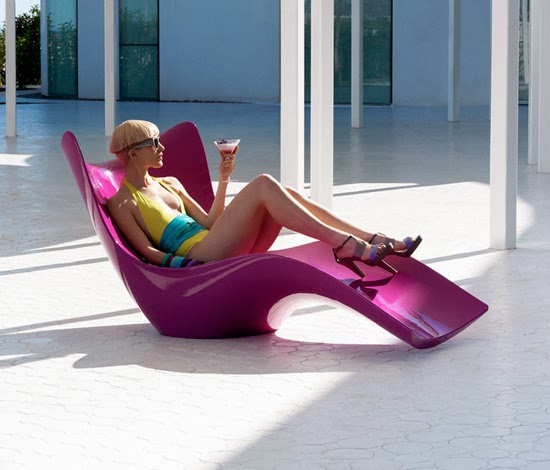For
my essay I wanted to talk about Eero Saarinen from the International Style and
Verner Panton from Pop Art Design. The reason why I chose these two particular
designers is because they both have made innovative discoveries which led to
revolutionary designs, especially in the area of moulds.
The
start for Eero Saarinen was to win the MoMA competition for the Organically
Shaped Furniture in 1940 with Charles Eames, when they created the Organic Armchair together.
After
the competition they both went their own separate ways and both made drastic
developments in design. Saarinen then created the Grasshopper and Stool which was inspired by Alvar Aalto’s Paimio chair.
Saarinen
still made use of wood bending but introduced more comfort to the chair by
adding the cushioning which was already introduced in the Organic Armchair but, as was the wood bending, it too was improved.
This improvement made the design look more stylish and comfortable which led Saarinen
to look back at the Organic Armchair
again and do further development to the design.
 These
developments lead to the creation of the Womb
Chair in 1947-1948. Apart from good looks and great comfort, this chair
also offers a sense of security to the person sitting in it thus he feels more
relaxed. The design of this chair also offers a variety of informal ways for
the body to occupy it. Saarinen realized that people did not want the rigidness
of the Victorian age so he created something in which one could truly feel at
ease.
These
developments lead to the creation of the Womb
Chair in 1947-1948. Apart from good looks and great comfort, this chair
also offers a sense of security to the person sitting in it thus he feels more
relaxed. The design of this chair also offers a variety of informal ways for
the body to occupy it. Saarinen realized that people did not want the rigidness
of the Victorian age so he created something in which one could truly feel at
ease. He
furthered his designs and started working on something innovative which, at the
time was quite unheard of, that of having a chair made out of one piece. Moreover
it was to have a single pedestal resembling a wine glass stem instead of the
traditional four legs; same goes for the table. This creation was the famous The Tulip Chair. It was not entirely
made out of plastic as Saarinen had wished for, but rather an equal combination
of both plastic and metal. In fact he stated that he was “looking forward to
the point when the plastics industry will be capable of manufacturing the chair
using just one material, the way I have designed it.”
He
furthered his designs and started working on something innovative which, at the
time was quite unheard of, that of having a chair made out of one piece. Moreover
it was to have a single pedestal resembling a wine glass stem instead of the
traditional four legs; same goes for the table. This creation was the famous The Tulip Chair. It was not entirely
made out of plastic as Saarinen had wished for, but rather an equal combination
of both plastic and metal. In fact he stated that he was “looking forward to
the point when the plastics industry will be capable of manufacturing the chair
using just one material, the way I have designed it.”
His
wish came true years later thanks to the hard work and further research and
development of Verner Panton. Panton had started his career as an apprentice to
Arne Jacobsen where Panton had assisted in the creation of the Ant Chair.
On
seeing his mentor’s works, Panton started to apply organic curves and bold
colours to his designs too. This led to the creation of the Cone Chair in 1958 which later led to
the idea of the Panton Chair in 1960.
By now it was just an idea.
It
took him almost a decade of research and countless experiments to come up with
the finalised form of the iconic chair we now today as the Panton Chair or the ‘S’ Chair.
It was made out of one whole piece of material which was considered immediately
a sensation once it went public. This chair is still considered as a classic of
modern furniture and is used by many in private homes as well as public
buildings.
This
could well be the start to Pop Art Design in which Panton’s role was to be the stepping
stone and a way of transition from the Organic Style to Pop Art Design. In fact
from this point Panton’s designs tend to be more playful and following trends
such as psychedelic, the idea of living in a habitat pod and the plan of
apartment sharing due to the hippy movement which later coined the term of
“good bourgeois taste” for such designs.
What
makes these two designers fascinating for me is the fact that although there is
quite a time gap between Saarinen and Panton they also started their careers at
different points but eventually converged and ended up working on the same
idea. That idea was to manipulate materials such as plastics in such a way to
create a particular design as whole by means of using moulds. Where one was
limited, thanks to the passing of time and the improvement in technology the
other could finish and make that original idea work and still is popular to
this very day.
Eero Saarinen. 1956. Vitra Design
Museum: Tulip Chair. [online] Available at: http://www.design-museum.de/en/collection/100-masterpieces/detailseiten/tulip-chair-no-151-saarinen.html [Accessed on 18th January 2014]
[online] Available at: http://www.dwr.com/category/designers/m-p/verner-panton.do?network=g&matchtype=b&device=c&gclid=CJ-Zwafr8bsCFUtP3godyhkAwg
[Accessed on 18th January 2014]
[online] Available at: http://theredlist.fr/wiki-2-18-393-1390-view-pop-design-profile-panton-verner-4.html
[Accessed on 18th January 2014]
Evad. May 2009. Colour Lovers: The Colours of Verner Panton.
[online] Available at: http://www.colourlovers.com/home/blog/2009/05/18/the-colors-of-verner-panton
[Accessed on 18th January 2014]
[online] Available at: http://www.1stdibs.com/furniture/seating/sectional-sofas/karim-rashid-omni-sofa/id-f_449571/
[Accessed on 18th January 2014]






.jpg)


.jpg)


















.jpg)








.jpg)



